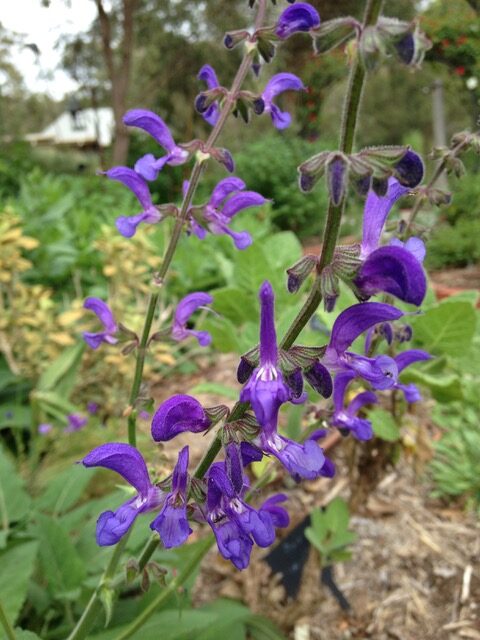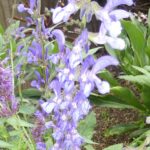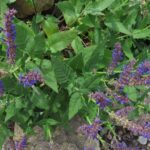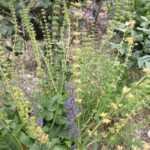Salvia pratensis ‘Indigo’:is a herbaceous perennial 60-80cmH with basal foliage and dark purple flowers in spring and summer.

This is a very fine form of Salvia pratensis.
Flowers: have a falcate shaped flower with a large opening between the hood and the lower lobes. The hood is a dark purple, large and curved with a purple stigma being exerted from the tip of the hood. The bottom lobes are a shade lighter with the middle lobe being cupped to hold a drop of moisture and acts as a landing place for insects visiting the flower. The throat is open wide with all the internal organs being white and inviting, coaxing the bee or insect to move further into the flower. The 2 side lobes are a similar colour, being tucked in neatly along the side.
Flowers are in whorls of 4-6flowers, in regular intervals up the green square stem. Multiple flower stems are produced which are held high above the rosette clumping foliage to attract any passing pollinating insects.
As the plant appears in early spring, the flower stems quickly appear, growing and setting flowers in late spring and continuing until early summer.
Calyces: these are primarily green with coloured ribs and purplish hairs. Each lobes is large and pointed. Calyces will remain on the stem after the flowers have finished, turning a straw colour and hopefully holding tiny round black seeds. Stems will have to be cut down in Autumn.
Leaves: are large, long and wide with pointed tips. A mid green colour with a textured surface and many small pointed lobes. Leaves are formed into a clump which expands slowly as it grows through the seasons.
Although showy during the summer season, this elegant Salvia ‘Indigo’ becomes dormant during winter.
Grow in full sun, in groups of 3-5 plants with other similar coloured herbaceous and evergreen perennials and small shrubs. When grown en mass they make a wonderful display with the deep purple being a contrast to any pale pink flowers near by.
Not fussy with soil, but should be well drained. If the soil is too heavy without enough compost/ plant matter incorporated, then there is a chance that the crown will rot and not appear again in spring.
Once established, these plants can be tough and hardy during summer with the occasional extra watering during the dry periods.
Maintenance: During the growing season, mulch well to keep the root area cool during the hot dry summer. During Autumn when the plant is preparing to go down for winter, collect any seed that may have formed, cut down all flower stems and clean up the leaf base. Mulch the crown to keep the root area warm during the cold months of winter.
When the leaves begin to appear, then feed well and top up the mulch.
Propagation: usually by seed sown in warmer weather, but any large clumps can be divided or small new growths can be taken off either as cuttings or potted up as rooted slips. for more tips, visit the propagation page.
Not readily available


